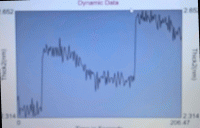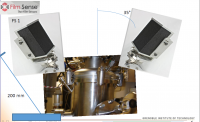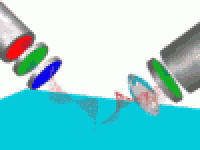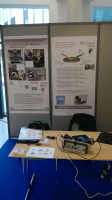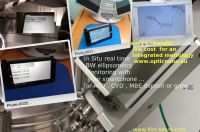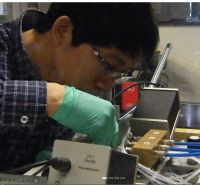Review of Refractive Index Refinements Process in few Mono layers Absorbents : Atomic Layer Deposition (ald) or Molecular Physisorption Phenomena analysis.
F. FERRIEU1 and C.VALLEE2
1OPTICNANO Scientific Consulting in Nano Technologies
Optical Polarimetry Ellipsometry & Solid State Physics.
CH-6945 (Switzerland)
2LTM CNRS France
Abstract: In situ Spectroscopic Ellipsometers (SE), is a precious real time process control tool. As frequently reported in literature, very thin layers measurements don’t yield however simultaneous and uncorrelated values for the thickness tF and the material refractive index (ri). Thickness value are highly related with the choice of “a priori” fixed value corresponding to the characteristic of the intrinsic layer’s nature . The paper discuss and implements earlier analysis of the initial P. Drude equations[1] : when thickness turns ultra thin, the ellipsometry equations can be approximated through a first order Taylorś expansion[2] in tF . During growth, deposition or in the case of physical adsorption on a substrate, as soon as few atomic layers are involved, this hypothesis is entirely fulfilled . After testing the way to proceed data, within simple examples, “physisorbed” monolayers case can be handled as well. The fixed physical configuration inside vacuum chambers acts with benefit over usual these limiting factors. The stability of alignment is just being done and one time fully optimized. With “no moving part” or “one single shot” photonics SE Ellipsometers within this configuration provides a complete sensitivity more than Surface Plasmon Resonance SPR.[3]. If SPR measures only the optical thickness, with the use of a limited number of wavelengths in SE, the real interest exists in a wide applications field when and depolarization factor consideration, gives additional information on the process. This is a large opening to bio photonic-sensors As it appears today s thin silica interacting with ambient and recognized as specific adsorbents material for gases and proteins detection as observed in sub “ native” oxides layers. Both refractive index and thickness with high accuracy. are independently reachable and within a rather fast acquisition capability. An evident interest appears to atomic layer deposition or etching (ald or ale ) as well for molecular beam epitaxy mbe and chemical vapor depositions techniques cvd and sputtering or pvd . Molecular physical adsorption and chemisorption are considered. Particularly in the CO2/H2O gas adsorption inter exchange, “one shot” ellipsometry turns the right tool with absorbent like thin or native sub-oxides.
I Experimentally, even with a wide spectroscopic range and variable angle techniques, Spectroscopic Ellipsometry (SE) instruments have been acknowledged to fall short in resolving this issue. Detecting monolayers and thin layers below this range is still today a challenge. The task in (SE) abound in various fields, particularly with adsorbed monolayers as within ALD technics but also in other fields like biology expertise in proteins analysis. Deposited or grown through molecular beam epitaxy are basically also atomic “monolayers”. For monolayers, the main challenge for many researchers lies in simultaneously determining these two parameters. In the field of biology applications, such as porosimetry, as previously stated by A.Arwin, "it is often stated that it is impossible, or at least very hard, to resolve both tF and nF for a thin film in an ellipsometry experiment" [4-5]. Today, other photonic designs are being implemented within SE instruments. The technique has been presented as a potential tool in other fields, such as immunology testing and "Adsorption of Proteins at Solid Surfaces" [5-6]. This has become a crucial expectation in current immunology research as a means of detecting antigens in the body. Methods like surface plasmon resonance (SPR) also measure refractive index variation, and significant efforts are being made to enhance their precision. In fact, the refractive index is expected to be known with an accuracy of approximately 10-3 to 10-4. Can ellipsometry be used for the same purpose? The paper attempt to give a realistic answer of this question
Introduction
Originally described as "transition layers" very earlier by P. Drude (Eq. 7, p. 287, and Eq. 36, p. 290, of ref [1] , these “top monolayers” must full-fill an electromagnetic field continuity while also being associated with adsorption with porosimetry phenomena.This topics is far away to have been overcome. In fact, last developments based on the early Drude Equations have prompted as a revisit of the limit of the Fresnel equations. In essence, this approach strives to accurately determine both the refractive index (nFilm) and film thickness (tFilm) through a comprehensive analysis of the theory. Importantly, it implicitly assumes the hypothesis of none disrupted interfaces, even within the few nanometers range. Building upon Drude's work, recent works [7] provides better insights into this analysis with taking into account of a physical interface continuity whereas current theories mostly revolved around the idea of a "transition layer", emphasizing the absence of discontinuities in nature. Hence, for the Fresnel equation to apply, there always exists discontinuity. As described it leads to a thin transition layer whereas the dielectric constant should evolve smoothly from one value to another. However as noted by Drude [1], see Chapt II-Transition of isotropic media and §7. Elliptic Polarization of the reflected light and the surface of transition layer”, it is argued at that time also that “when light passes from ambient 1 to the substrate medium 2 there is a discontinuity at the interface. But strictly speaking there is no discontinuity in nature” with always a thin transition zone within which the dielectric constant varies from to . Unambiguously the native oxide layer is to be included as light visible wavelengths are much larger than the depicted interface. Inclusion in a second order development of the complex ratio ρ = Rp/Rs versus X=( 2π tF /λ)~0, where is the film thickness, is then obviously mandatory. Asremains constant in that transition layer, it should mean “a fortiori “ that . In many cases furthermore, one deals also with mostly transparent substrates, even if silicon substrate is far to be transparent to the eyes, but imaginary (imag) index k(633nm)~0.018) absorption is very small. So far a first order Taylorś approximation can be established with through a moment Taylor’s expansion. The real part of ρ, (Re(ρ )), and the square of it’s imaginary part [1][7]. as real(ρ) and Imag(ρ) appear as key specific quantities and plays a predominant role [1],[7]. Recent authors have also reiterated this concept in the literature. Specifically, the equations from Drude description (Eq. 7, p. 287, and Eq. 36, p. 290, in ref [1]), are rewritten as Eq. 5 and Eq. 6 in [7] As a remind to the reader , they are simply only reported here:
(2a)![]()
![]()
with (2b) ![]()
in short as (2c) ![]()
Here, the indices 1, 2, and F correspond to the ambient medium, substrate, and film, respectively. The angle of incidence (aoi) and the transmitted angle are denoted as θinc and θtra, respectively. The direction of the transmitted light inside the substrate is determined using Snell's laws.(eq 4.3 p.271 in [8]. From the second-order Drude expansion versus X=(2π tF / λ) the second moment contains the slope S, which is a function solely dependent on the intrinsic refractive index nF of the upper film, regardless of the layer thickness tF. In the case of a fully-filled atomic layer growth, successive acquired data yield equally repetitive abscissa steps of Imag(ρ)². In the case of a monolayer on top of a substrate (ambient-1 layer-2 substrate), as asymptotic limits the equations (4.37 and 4.38, p.285 in [8]) can be used to calculate Rp and Rs exactly, given the known refractive indices n2 and k2 from published data [9], as well as the angle of incidence (aoi) obtained from experiments. By recalculating Rp and Rs acted from the observed slope S using these analytical equations [1].( see classical limit estimation from eq 4.37 and 4.38 p.285 in [8]). From this linearity, the distance between each of these points can be measured, providing information about the film thickness as well as changes in the refractive index nF -
Experimental complex ratio ρexp are obtained as ρexp = (C + iS)/(1+N), where N = cos 2Ψ, C = sin 2Ψ cos Δ, and S = sin 2Ψ sin Δ. These elements correspond to the ideal isotropic Mueller-Jones matrix.
The SE instrument provide real time streaming files of Ψ, Δ in degrees, and another parameter , the depolarization Pexp for each LED source wavelength [10].This last parameter will be reconsidered hereafter.
X-Y 2D mapping on a silicon wafer is a straightforward method for testing the approach. Traditionally employed earlier with beveled samples for refractive index determination, it can also be easily adapted for "non-homogeneous" samples. By manually displacing a wafer sample on the instrument holder in the x-y 2D planar direction, streams of measurements can be taken . Certain regions of the wafer can be considered closest to a bare substrate [7], such as in our case Zno at 300°C [11] or with thin alumina (Al2O3) atomic layer deposited (ald) samples. This choice is comforted by existing literature and data base sites on refractive indices[9].These previous experiences prompted to control the utilization of an ellipsometer to monitor the potential adsorption of different environmental gases in the surroundings.
Environment ambient considerations
With the advancements in Internet of Things (IoT) technology, a multitude of affordable sensors are now capable of providing real-time data on gas composition, environmental parameters, i.e., temperature, and pressure. The objective is to showcase the capabilities of the instrument when operating within a controlled atmosphere and to examine how the gas ambient environment influences material surfaces. The potential application of ellipsometry as a biosensor has already been established in the literature, with detailed discussions and initial findings highlighting the opportunities presented by this technique.The integration of this new generation of IoT sensors enables the convenient monitoring of multiple ambient parameters simultaneously. To demonstrate this capability, a gas control chamber has been constructed around the instrument, operating at ambient atmospheric pressure, and the entire setup is controlled remotely. Within this chamber, various sensors are employed to measure CO2 concentration (ppm), as well as other potential gases such as N2, NH3, CO, CH4, and / or O2 percentage (%). Additionally, ambient data such as pressure (in hPa), relative humidity (%RH), temperature (in degrees Celsius), and particle counts (in ppm for P 2.5µ and 10µ) in the clean room are also monitored. The %RH values can be easily converted to ppm volume [12]. The measurements of these different gas species are performed simultaneously, with the adjustment of the delay between each experiment, extending over several hours and integrating data from up to 6 sensors. The acquisition rate is limited by the response time of the sensors (1 second), while the our SE instrument operates at a rate of up to 50ms with 4 wavelengths. Prior repeatability measurements were conducted over several days under controlled conditions, including stable temperature and atmospheric pressure control (within one Celsius and normal daily pressure variations) [15].
Exploring the different adsorption processes involved, the most commonly recognized one is being the ambient process of carbon dioxide (CO2) adsorption[13]. The technologies employed for capturing atmospheric CO2 primarily rely on adsorption/absorption processes, predominantly utilizing aerogel compounds. Silica is commonly chosen as a mesoporous material, frequently mentioned in relation to "low k" dielectrics in integrated circuits (IC)’s. Indeed significant extensive research has been conducted in the broader field of these materials, and significant references are available in the literature.
The phenomenon of "physical adsorption" describes the interaction between an ionic solid and an electrically neutral, but polar gas adsorbate molecule. A classic example is the binary carbon oxide (CO2) and water (H2O) present in the ambient atmosphere. This interaction occurs between a thin oxide layer, mostly bound to the surface, and a polar adsorbate through quadrupole interactions. Relative humidity is assumed to play a catalytic role in this process.
It is worth noting the inverse effect, where the relative humidity content (%RH) significantly affects the thermal kinetic silicon oxidation rate, also due to catalysis. In the adsorption isotherm process, even a small amount of water in the gas mixture has a notable impact on adsorption loads and CO2 capture. In fact, a minimum humidity level is necessary to initiate and enhance such a process.
However, to our knowledge, there is still limited understanding of the precise mechanisms involved in the reaction of carbon dioxide at the adsorbed water-oxide interface. A thin water film, estimated to be roughly two layers thick when the relative humidity reaches 100%, likely plays a critical role. It is crucial to comprehend the "chemistry" of these "wet" interfaces within the atmospheric gas [12-18]. By influencing the chemical nature of the predominant adsorbed product on the surface oxygen bonding, H2O enhances CO2 uptake, transitioning from unsaturated silicate to carbonate. The resulting thin water film should exhibit an acidic nature, arising from the reaction of CO2 , transforming unsaturated hydroxyl SiO-H groups into -C=O-OH bridges.
In classical porosimetry measurements, when employing the classical approach, which involves acquiring the t-curve reference model, changes and increases in the "effective" thickness are observed, even though the effect is minuscule. To clarify, the term "classical" refers to the use of the instrument's reference calibration model, which assumes a fixed oxide layer index while allowing other parameters, such as the incidence angle (aoi), to vary. The fitting process involves measuring an equivalent thickness. However, it is important to note that measuring an equivalent thickness (or t-curve) completely ignores the actual chemical structure of this effective layer, instead demonstrating the presence of a similar "physi-adsorbed" layer on top. In practice, most reports utilize t-curves when conducting classical porosimetry isotherm analysis.
Using a first classical approach, i.e., acquiring the t-curve reference model, change and increase of an “effective” thickness are observed even in a so tiny effect. To say shortly, with “classical”, it means use of the instrument reference calibration model, i.e. a fixed oxide layer index with another varying parameters as the incidence angle aoi. The fitting concerns measure of an equivalent thickness.
Figure 2a Equivalent thickness in Angströms return isotherm t-curve versus time in secs .
Measuring this equivalent thickness (or t-curve ), turns as being absolutely ignoring the real chemical structure of this effective layer but demonstrating some presence of a similar “physi-adsorbed” layer on top. In reality, most reports use t-curves while considering classical porosimetry isotherms analysis. Here,only two aspects can be deduced from this basic curve : a) the reversibility: a fast reaching time interval forward saturation state followed by a slow in time desorption and b) a thickness range scale of only few nanometers. It should be of adsorption the order or less than one to 20 angstroms-thick layers (0.1 to 2nm). The analysis shows that this thickness change is above the SE today’s repeatability. The question on how the H2O content induces the adsorption of CO2 or reverse remains unanswered. From the Iot sensors readings, only the water H2O relative humidity, i.e., ratio %RH and CO2 ppm H2O/Carbon dioxide ratio are recorded together with ellipsometry C,S, N data . A real linearity exist in between these two parameters.
Fig 2 b Observed linearity in between ppm H2O concentration and carbon oxide ppm CO2
The Figure 2a report in abscissa, the equivalent thickness curves measurements : Equivalent Thickness (EQ)-thck(nm) or also denominated as “t-curve” and shown here versus the %RH content whereas linear equivalence between %RH and CO2 (ppm) remains. From this basic curve, only two aspects can be deduced: a) Reversibility: There is a fast initial saturation state followed by a slow desorption over time. b) Thickness range: The thickness change is within a scale of a few nanometers, likely ranging from one to 20 angstroms (0.1 to 2nm).
Previous authors claimed this effect as due to presence of polar CO2 (-OH+C+HO-) leads to bond bridges with surfaces activated by the H2O layer. The water (H2 O) plays a catalytic oxidant role in enhancing this context. In the surface chemistry of carbon dioxide, the combination of a molecular water layer on the SiO2 oxide interface is thus of fundamental importance. This interface chemistry has also been discussed in other aerogel-like, structured zeolites. It is intriguing to consider the formation of these "wet" interfaces within the atmospheric gas. However, the detection level is expected to be on the order of a few nanometers. The competition between CO2 and H2 O capture is even depicted in the literature [16-18], with a two-site Langmuir equation previously proposed to describe this effect. However, the question remains as to whether the CO2 adsorbate forms a super layer on top of the silica or if it is completely adsorbed within the adsorbent silica layer, modifying the overall refractive index of the layer. Recently, the latter possibility has gained attention, and our results can be seen as a clear demonstration of this "sponge-like" capacity. It should be worth exploring whether this effect applies to other adsorbates, as shown in recent studies and future when considering biology and immunology involving antigen proteins. As this simple example, human breathing can unsurprisingly be seen as a mixing of humidity and CO2 .
Formerly the Drude procedure reviewed in ref [7], underline a key point . As a reminder, solving equations (2) and (3) with the slope S enable to obtain the film index value. These equations can be re-formulated and just applied to the case of an isotherm adsorption kinetic versus time t. That is, when calculating the experiment slope versus time:
(7)
Thus the variable t is the time evolution of the complete layer. An initial value tinitial corresponds to the bulk substrate without or with any layer , (the ideal should be perfectly clean bare substrate sample), before starting the process. For real sample it will be in fact, the native oxide layer always present on top of the substrate and seen here, as the adsorbent material. Furthermore,which can be evaluated from eq (3) or measured from acquisition global data from the origin ordinate. The slope S equation for is deducible, using any symbolic mathematics solver. It yields equation as in [7], deduced from the Drude model ( as shown and extracted from Drude analysis page 290 eq(36) from [1]:
(7.a)
from which can be extracted
(7-b)
This capability can be integrated into real-time acquisition software, which allows for simultaneous gathering of ellipsometric parameters and various ambient concentrations such as CO2 in parts per million (ppm), relative humidity (%RH) or water vapor (H2O) in ppm, as well as ambient pressure and temperature. These data can then be conveniently re-analyzed using standard Excel software once the experiment is completed. In Figure 3, the refractive index change in relation to CO2 concentration in ppm is depicted. The analysis demonstrates a remarkably high level of accuracy, as the changes in the refractive index remain well below the noise level of 10⁻⁴.
Fig 3 the refractive index versus the CO2 concentration in part per million (ppm)) as calculated l from the Drude analysis,(Eq.7 )detailed below.
Within the r. i., the refractive index nF ,the effective medium approximation EMA,[eq 8-9], provides a volume fraction V, i. e., .the occupied volume fraction by H2 O,(Eq.9)
To consider is the total porosity Vm which represents the proportion of filled voids in the porous layer volume V. Proceeding further with the mixing EMA theory a total pore size volume V/Vm fraction
(8)
where ns is the known adsorbent native oxide refractive index r.i. andthe measured r.i. of the film index value. From the measured refractive index n. From the equilibrium between the evaporation and condensation rate at a surface, as described earlier by Brunauer, Emmet and Teller [20] and since the adsorbed volume tends to infinity once p approaches ps, we may write the following equation:
(9)
This later Vm is also called the monolayer coverage capacity which can be generalized to the upper value, and p the partial pressure versus the adsorbate liquid saturation pressure ps, here it will be simply the H2O adsorbate %RH. For a constant temperature, the evolution of this surface adsorbed layer thickness t is usually depicted in the literature and currently presented as a t-curves isotherm. But the t thickness as being measured with an a priori value of the refractive index is not clearly defined. It can be usually simply related to Eq. (2) with (10) where d’ is the monolayer effective thickness. Another parameter is also present: the monolayer capacity coefficient rate is seen as a thermally activated coupling factor related to temperature T and bondings activation Energy and thenwith kB the Boltzman constant. In fact, this early theory rapidly failed. Indeed, one has to analyze the isotherm t-curves by reference to all present additional surface forces including the adsorbate themselves interactions. Beside these classical BET equations, theories accounting with the other surface energy interactions emerged later. One of these approaches came from Halsey in 1948, referred as the FHH theory. The multi- layers ‘‘build-up’’ by water adsorption on a clean surface at low partial pressure comes from the interface intensity (and the nature) of long (London (LD) forces), or short (Debye and Keesom interactions) range forces between the water molecule and the analyzed surface. Various approaches have been invoked to answer to their intensity could theoretically be extracted from the isotherm data.
A measure of the film thickness, probes the geometry of the surface over this range of scales. In the FHH case, the number of adsorbed molecules N and the monolayer coverage Nm turns to be related to the fractal dimension D through the Minkowski dimension . In the second BET fractal theory [10],the model takes into account the multi-layer filling along a Koch curve [20]. One get the fractal dimension D from a, but also the other corrected BET parameters, i. e., Cm (BET constant), a function of both adsorbate and adsorbent, a function of temperature T, as well and with Vm the monolayer coverage and the partial pressure p = p/psaturation one has a good approximation only for 0< < 1 and p < 0.75. Here if
(10) where D represents the surface fractal dimension of the layer. The adsorbent initial layer present on the substrate, ( here ns< or ~1.457 at 633nm for a native oxide).The results are provided below. On the first row left is the refractive index at 637nm (RED LED) within the desorption process and right the corresponding t-curve versus time. Below, left one sees that the ratio CO2 ppm over ppm H2O remains constant along the experiment , as roughly ~20%. The last plot is a linear fitting representation of a fractal eq(14) see details inset figure below .As far the ratio is evaluated from Eq.(8) and the monolayer effective thickness d` known, the t thickness can then be completely evaluated and which yields here to D=1.2877
Fig 4 As far the ratio is evaluated from Eq.(8) and the monolayer effective thickness d` known, the t thickness can then be completely evaluated and which yields here to D=1.2877
Depolarization effect are generally traduced b the Mueller matrices formalism As depicted in Eq.6 a Mueller matrix with N,C,S components is a perfect so-called Mueller-Jones. But it remains unrealistic in nature. The developments to Generalized Ellipsometry, while considering real data, G.E.Jellison included such a “depolarization factor” ,writing then from the ideal Mueller Jones eq(6). It turns to an isotropic but depolarizing mueller matrix ;
(12
The polarization factor turns to unity, , ideal limit in the case of a perfectly smooth surfaces. One inset one must figure out then the following scheme of the physically realizable Mueller matrix equivalence describing the stokes vectors on a normalized Poincaré Sphere and with P<1 (whereas the dimmed sphere correspond to the unity scheme)
|
Fig 10 Physically realizable Mueller matrix equivalence describing the stokes vectors inside the normalized Poincaré Sphere and with P<1 (whereas the dimmed sphere correspond to the unity scheme)
|
Due to experimental errors with sometimes is observed and introduces erroneous informations on light scattered from surface. This discussion topic is still on discussion with the instrument provider from Film sense[10 ] .
In Fig 10a, the experimental depolarization factor Pexp provided from the experimental data in fact should be less or equal to the dop factor . in fact measurements provided values even greater than unity. This inconsistency ,(with a depolarization factor expected less or equal to unity,i. e. with or (depolarizing) ), leads to reconsider this experimental value At a first order, it has to be normalized respect to it maximum value as dop=Pexp / Pexp`max Nevertheless the complete Cloude [ 22], filtering of the Mueller matrix should be the right polarimetry answer. The associated system Neumann Entropy, Fig 10 with
Eq(13) :
shows these variations along this theoretical curve
Fig. 10 Depolarization analysis at the 4 LED sources wavelengths during the desorption process (left normalized here). is less than one or equal to unity as soon as the system retuns to ambient total partial pressure equilibrium Corresponding Newmann Entropy following Eq 13 (on the right), [24].
For each of these different wavelengths, the experimental normalized dop data inserted in Equation (13) are the associated with a and, as it is observed here, clear return to a null Entropy For each of the 4 wavelengths this return fo a full isotropic surface as soon as desorption is ending.(i. e. with a dop equal to unity.) mean the perfect surface. This is a clear checking that with a full Mueller matrix measurement instrument , i. e. a full single shot polarimeter has the potentiality to detect a complete atomic layer filling-The film thickness can furthermore refined consequently giving values of any analytical law valid in the visible range. The need of a fast real time acquisition ellipsometer is completely full-filled with a 50ms acquisition rate .As comparison with an optical emission spectrometer (OES),a classical deposition carried out by PE-ALD (100 cycles) is monitored only at an acquisition rate of 200 ms. The remote capability enable furthermore a plain process control. Indeed the refractive index of the monolayer can be followed during the multiple cycles when building the film. Native oxide reveals to be very sensitive to ambient gas environment.
These observations might be in a near future consequently used in the basic concept of monolayers biosensors within the today’s proteins detections which are today highly requested in immunology and environmental ambient studies. In a context such as that of nanotechnology it is important to know the surface states of the materials deposited in thin layer and thus SE is determinant.
Various papers exist on the study of surface adsorption (SAXS, SANS, N2 adsorption, positron annihilation, but quite few exist for thin layers. No a priori technique can be chosen through other optical detection method for surfaces. Spectroscopic ellipsometry has the advantage of being adaptable to the case of many studied material and can be done in situ. All surface analysis methods are destructive. XPS analysis, SIM, or AFM or SEM imaging only gives a local idea. The closest method could be haze measurements , but scatterometry remains with very great difficulty to analyze . . A scale of a few angstroms when the size of the adsorbate is the etalon unit . Today, it is difficult to extract truly realistic information except in this latter case, Insofar in the clean room conditions in terms of cleaning and desorption will be carried out even in the most reproducible manner. Nevertheless, the effects demonstrated by this review are striking and confirm the potential of Ellipsometry, hence the interest of taking precedence over many techniques.
SE has been reviewed here as a method of surface analysis which uses a scale of the size of a molecule to measure the roughness of a surface, and its dimensionality. Among the monitoring of adsorption and optical surface observation the technique is unique :
The use of the ellipsometry ratio ρ linear relationship between real and the square of its imaginary par is a key procedure when performing the data analysis. In a very reduced thickness range, i.e., below 5nm, this analysis demonstrates a way to obtain the absolute value of the refractive index independently of other parameters.The thin film index is deduced from the slope of the kinetic equation real(ρ(t))=versus im(ρ))² plot the Nestler,Ham equation 7-b. Concerning the SE choice, no more than four LED sources wavelengths demonstrates that not so many wavelengths are usefull. Furthermore with the knowledge of one monolayer thickness, one can be very confident in total multilayer thickness in the total ald processing. Beside the interest of getting new single shot SE, going further to polarimetry is very promising technique. Depolarization effects provide information on total layer filling. A full Mueller matrix measurement instrument , i. e. a full single shot polarimeter is able to detect it. Ellipsometer or polarimeters are the most accurate tools for surface analysis. Their limit should even will reach a quantum noise “glass ceiling”. That was seen earlier as due to the intrinsic source “photon noise limit”[11-a]. But new quantum dots pulse light sources could overcome it. This important aspect indeed goes with the scaling down of samples when below the 5 nanometer thickness range. This present analysis shows the first mechanism present and give an a priori set of methods in order to solve them.
Bibliography
[1] P. Drude, The Theory of Optics (Longmains, Green and Co., 1902).
[2] https://en.wikipedia.org/wiki/Taylor%27s_theorem
[3]”A theoretical approach to detect SARS-CoV-2Nano-layered SPR surface plasmon resonance-based highly sensitive biosensor for virus detection”:Md. Moznuzzaman,1 AIP Advances 11, 065023 (2021); doi: 10.1063/5.00
[4] H. Arwin ICSE4 Stockholm and ref 6 chapt 12
[5] H.Arwin Applied Optics 43,15,3028 (2004) TIRE experiments
[6]”The Density and Refractive Index of Adsorbing Protein Layers” Janos Vörös Biophysical Journal Volume 87July 2004 553–561 see the Feijter's formula (de Feijter et al., 1978)
[6a]Investigating Protein Adsorption via Spectroscopic Ellipsometry Maria F. Mora, Jennifer L. Wehmeyer, Ron Synowicki,and Carlos D. Garcia. Biological Interactions on Materials Surfaces,
[7].P. Nestler, C. A. Helm ,25, 22,2707, Opt.Express (2017).
[8] R.M.A. Azzam and N.M. Bashara “Ellipsometry and polarized light” :ISBN 0 444 87016 4 , see also p.436 Chapter 6
R.M.A. Azzam Journal of Vacuum Science & Technology B 37, 060802 (2019)
https://doi.org/10.1116/1.5122802
“Handbook of Ellipsometry” G.Tompkins & E.A. Irene W.A.Publishing ISBN 3-540-22293-62005
”Stokes-vector and Mueller-matrix polarimetry”
R.M.A. Azzam 1396 Vol. 33, No. 7 / July 2016 / JOSA A
[9] https://refractiveindex.info/ and previous analysis like :F. Ferrieu J.H. Lecat JES vol 137, 7, 2203 July1990.
[10] see https://www.film-sense.com and FS-1 manual user’s guide
[11] E.V. Skopin,* J.L Deschanvres, and H. Renevier Phys. Status Solidi A2020, 1900831 (2020). [9-a] ZnO and Al2O3 data made available with courtesy of J.L.Deschanvres , RAFALD 2015 Workshop Grenoble (France)
[12] "A Simple Procedure for Calculating Atmospheric Water Vapor Concentration", Gregory J. McRae (1980)Journal of the Air Pollution Control Association, 30:4, 394-394, 1980.
[13]”Surface Reactions of Carbon Dioxide at the Adsorbed Water−Iron Oxide Interface “J. Baltrusaitis ,VH. Grassian J. Phys. Chem. B 2005, 109, 25, 12227–12230
[14] "A Simple Procedure for Calculating Atmospheric Water Vapor Concentration", Gregory J. McRae (1980)Journal of the Air Pollution Control Association, 30:4, 394-394, 1980.
[15] A prototype version could be deliverable please contact the author
[16]”Understanding the effect of H2O on CO2 adsorption capture: mechanism explanation, quantitative approach and application “,Sustainable Energy & Fuels · November 2020 DOI: 10.1039/d0se01179g
[17]”The Role of Water in Adsorption-based CO2 Capture Systems”. Dorian Marx et al. / Energy Procedia 37 (2013) 107 – 114
[18] “Adsorption of carbon dioxide, methane, and their mixtures in porous carbons: effect of surface chemistry, water content, and pore disorder” P. Billemont, B. Coasne, G. De Weireld DOI:10.1021/la3048938 CID: 19607386 2013
[12] "A Simple Procedure for Calculating Atmospheric Water Vapor Concentration", Gregory J. McRae (1980)Journal of the Air Pollution Control Association, 30:4, 394-394, 1980.
[11]US pat US6233380 05/15/2001 , US6791684 09/14/2004 ST N0 0504036 22.12.2005 US pat ST N0 0504036 22.12.2005 US pat ST N0 0504036 22.12.2005 US pat F.Ferrieu
[11a]”Fundamental quantum limits in ellipsometry” Ł. Rudnicki,1,2 L. L. Sánchez-Soto, G. Leuchs and R. W. Boyd,Optics Letters ,Vol. 45, No. 16 / 15,4607, August 2020 4607
[14] Application note.US Patent #9,354,118
[15] A prototype version could be deliverable please contact the author
[16] "A Simple Procedure for Calculating Atmospheric Water Vapor Concentration", Gregory J. McRae (1980)Journal of the Air Pollution Control Association, 30:4, 394-394, 1980.
[17] Hans-Jürgen Butt, Karlheinz Graf, Michael Kappl “Physics and Chemistry of Interfaces”. Hans-Jürgen Butt, Karlheinz Graf, Michael KapplISBN: 3-527-40413-9(2003).
[18]”Understanding the effect of H2O on CO2 adsorption capture: mechanism explanation, quantitative approach and application “,Sustainable Energy & Fuels · November 2020 DOI: 10.1039/d0se01179g
[18-a]“Investigating Protein Adsorption via Spectroscopic Ellipsometry” Maria F. Mora, Jennifer L. Wehmeyer, Ron Synowicki and Carlos D. Garcia. Biological Interactions on Materials Surfaces,DOI 10.1007/978-0-387-98161-1_2, © Springe 2009
[18-b]”Computation of Refractive Indices of Corona Viruses” Current Optics and Photonics Vol. 4, No. 6, December 2020, pp. 566-570
[19]”The Role of Water in Adsorption-based CO2 Capture Systems”. Dorian Marx et al. / Energy Procedia 37 (2013) 107 – 114
[19-a]Adsorption of carbon dioxide, methane, and their mixtures in porous carbons: effect of surface chemistry, water content, and pore disorder.P. Billemont, B. Coasne, G. De Weireld DOI:10.1021/la3048938 CID: 19607386 2013
[20] “Physical surface adsorption and Molecular Surface Fractal Analysis (MFSA) detected with
Spectroscopic Ellipsometry “ F.Ferrieu , J-L Stehlé Applied
Surface Science 256S (2009) S96–S100
[21]
[22]”Mueller matrix metrology: Depolarization reveals size distribution” Appl. Phys. Lett. 115, 063106 (2019); https://doi.org/10.1063/1.5094409 I Voloshenko, B. Gompf.
[23]”Polarimetry of light scattered by surface roughness and textured films and periodic structures in nanotechnologies: a new challenge in instrumentation and modeling” F. Ferrieu, NanoCharM Workshop on Advanced Polarimetric Instrumentation EPJ Web of Conferences Volume 5, 2010 API'09 504001 (2010)https://doi.org/10.1051/epjconf/20100504001
[24]”Molecular level investigation of methane and carbon dioxide adsorption on SiO2 Surface “J. Zhao, Z. Wang,P. Guo, Q. Luo Computational Materials ScienceVolume 168, 2019,213-220 (2019)
[25]”Mueller matrix metrology: Depolarization reveals size distribution”. L. Voloshenko et al Appl. Phys. Lett. 115, 063106 (2019); and https://doi.org/10.1063/1.5094409

